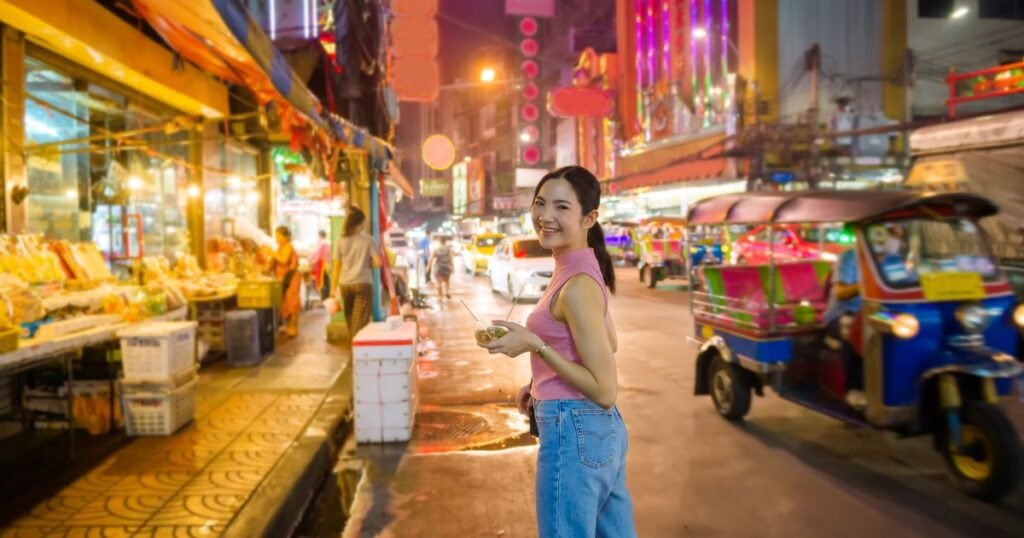South East Asia has long been a magnet for travellers seeking adventure without a hefty price tag. The region is a tapestry of ancient cultures, dynamic cities, and breathtaking natural landscapes, all accessible on a modest budget. But travelling cheap is not just about finding the lowest prices; it’s about travelling smart. It requires a mindset of flexibility, a willingness to embrace local ways, and an understanding of where your money goes the furthest. Managing your budget is like steering a ship through a vast ocean; with the right map and a steady hand on the rudder, you can navigate your way to incredible experiences without running aground financially.
This guide will walk you through some of the best-value destinations in the region and provide the foundational knowledge you need to make your travel funds stretch further, allowing you to stay longer and experience more.
Before diving into specific countries, it’s crucial to understand the universal principles of saving money in this part of the world. These strategies are the bedrock of any successful budget trip and apply almost everywhere, from the mountains of Northern Vietnam to the islands of the Philippines.
Timing Your Trip: The Shoulder Season Advantage
When you travel has a massive impact on your expenses. South East Asia generally has three seasons: high, low (or monsoon), and shoulder. The high season, typically corresponding with the best weather, sees the highest prices and biggest crowds. The low season offers the cheapest deals, but you may face persistent rain that can disrupt travel plans.
The sweet spot for the budget traveller is the shoulder season. This is the period between the high and low seasons. The weather is often still very pleasant, the crowds have thinned out, and accommodation and tour operators are more willing to negotiate prices. You get most of the benefits of the high season without the peak-season costs. Research the specific shoulder season for your target country, as it varies. For example, in Thailand, this might be April-May or September-October.

Accommodation: Your Biggest Cost Variable
After flights, where you sleep will likely be your largest daily expense. The good news is that South East Asia offers a vast spectrum of options. For the true budget traveller, hostels are the go-to choice. A dorm bed provides a place to sleep, a social atmosphere, and often a wealth of local knowledge from fellow travellers and staff.

A budget hotel I stayed in Kuala Lumpur in August 2024
If you desire more privacy, guesthouses and family-run homestays are excellent alternatives. They are a step up from a hostel in comfort but are still significantly cheaper than hotels. In many places, you can find a clean, private room with a fan and a private bathroom for a very reasonable price. While booking sites are useful for securing your first night, don’t underestimate the power of simply arriving in a town and walking around. Many smaller guesthouses aren’t listed online and offer competitive rates to walk-in customers.
Food: Eating Like a Local
One of the greatest joys of this region is the food, and thankfully, the best food is often the cheapest. Your culinary compass should always point towards street food stalls and local markets. This is where you will find the most authentic and flavourful dishes for a fraction of the price of a tourist-oriented restaurant.
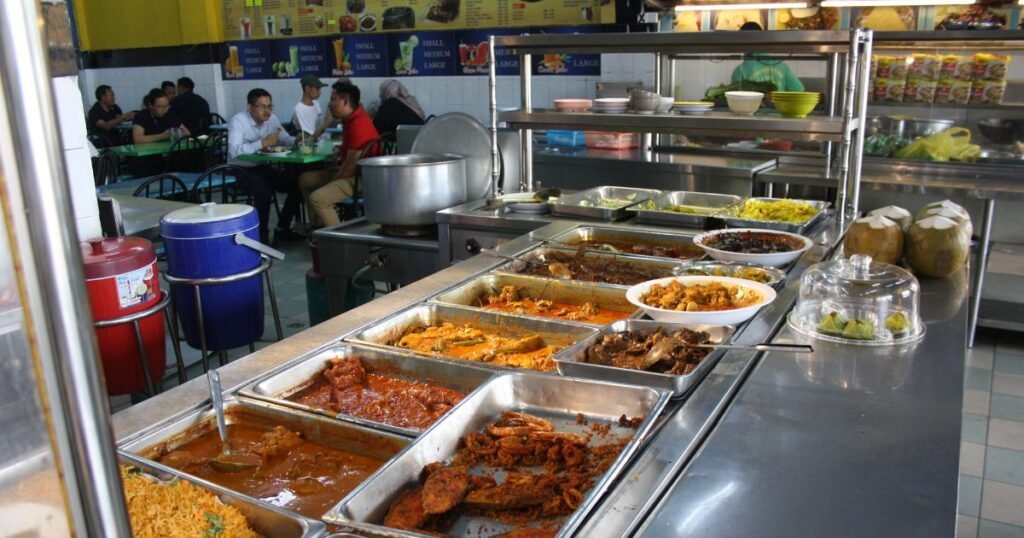
Nasi Kandar a popular food across Malaysia
Don’t be intimidated by the plastic stools and bustling atmosphere. Pointing at what looks good is a universal language. Eating this way not only saves you a significant amount of money but also immerses you directly in the local culture. A sit-down restaurant with an English menu and air conditioning might charge you three or four times more for a meal that is often less authentic. Make local markets your primary source for fruit and snacks, and make street food your default for meals.

Foodcourt in Makati Manila, The Philippines
Transportation: The Slow and Steady Route
Getting around is another area where you can achieve huge savings. While budget airlines offer convenient ways to hop between countries, overland travel is the champion of cheap transport. Overnight buses and trains are a backpacker’s best friend. They cover long distances while you sleep, saving you the cost of a night’s accommodation. They may not be the most comfortable night’s sleep you’ll ever have, but the savings are undeniable.

Popular bus service connecting Malaysia with Singapore
Within cities and towns, resist the urge to take a taxi everywhere. Learn to use the local transport, whether it’s the songthaews (shared pick-up trucks) in Thailand, the jeepneys in the Philippines, or simply renting a bicycle in a small town. Ride-sharing apps like Grab are prevalent in many countries and are almost always cheaper than traditional taxis. For ultimate freedom, many travellers rent a scooter. It’s an affordable way to explore at your own pace, but only do so if you are an experienced and licensed rider. Always wear a helmet and have appropriate travel insurance that covers you for two-wheeled vehicles.
Vietnam: A Journey Through Contrasts
Vietnam stretches over 1,600 kilometres from north to south, offering a remarkable diversity of landscapes and experiences. It remains one of the most affordable countries in South East Asia, where your money goes a very long way.
Why Vietnam is Budget-Friendly
The country’s low cost of living translates directly into low costs for travellers. A delicious bowl of pho or a crusty banh mi sandwich can often be bought for little more than a dollar. Accommodation, from bustling city hostels to rural homestays, is plentiful and cheap. The country’s elongated shape also makes it perfect for a logical, cost-effective overland journey, either from Hanoi in the north to Ho Chi Minh City in the south, or vice-versa. This well-established route, often called the “backpacker trail,” is serviced by a network of affordable buses and trains.
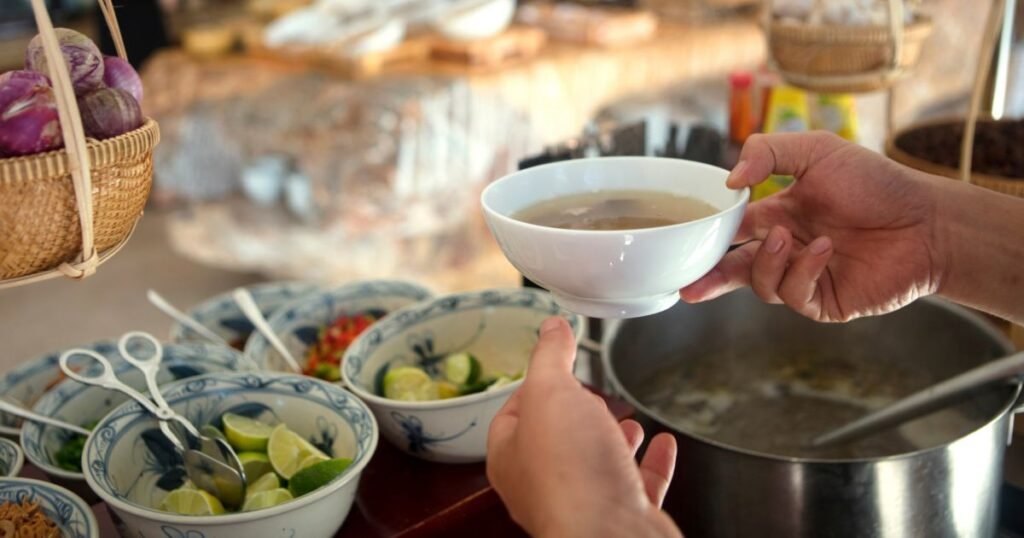
Pho a popular soup in Vietnam
Key Budget Areas
While the entire country is affordable, some areas offer better value than others. The north, including the capital Hanoi, is generally cheaper than the south. From Hanoi, you can take affordable multi-day trips to see the limestone karsts of Ha Long Bay or explore the mountainous regions of Sapa and Ha Giang. The Ha Giang Loop, a multi-day motorbike journey, is a legendary budget adventure that offers some of the most spectacular scenery in all of Asia.
Central Vietnam, with Hoi An and Da Nang, is beautiful but can be more tourist-focused, so you need to be more deliberate with your spending. In the south, the Mekong Delta offers a fascinating glimpse into rural life, with inexpensive boat tours and homestays available.
Sample Daily Budget
A frugal backpacker in Vietnam can comfortably get by on $25-$35 per day. This would typically cover a dorm bed, three local meals, some light transportation, and a cheap local beer (bia hoi) or two. Even with private rooms and the occasional organised tour, it’s difficult to spend more than $50 a day unless you are actively seeking luxury.
Cambodia: History, Resilience, and Value
Cambodia offers a powerful travel experience, combining the awe-inspiring ancient history of the Angkor temples with a sobering recent past. It is also an exceptionally cheap country to travel in, making it accessible to nearly everyone.
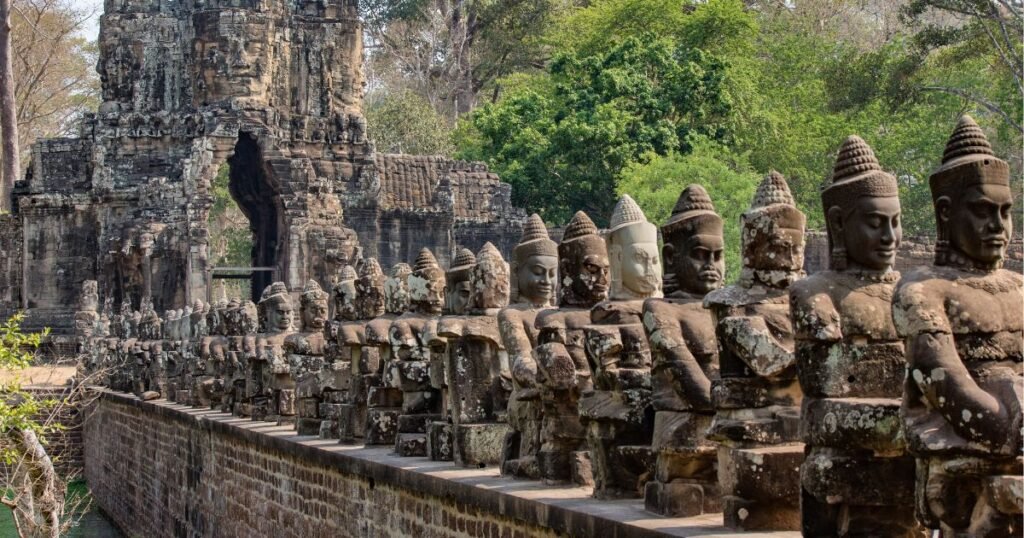
Angkor Wat in Cambodia
Understanding the Costs
Cambodia’s economy is heavily dollarized, meaning the US Dollar is used for most transactions alongside the local currency, the Riel. This can be a double-edged sword. While convenient, it can sometimes lead to prices being rounded up. Always carry small US dollar bills and be prepared to receive change in Riel. Outside of this quirk, daily costs are extremely low. Guesthouses in cities like Siem Reap or Phnom Penh offer private rooms for very low prices, and street food is both delicious and incredibly cheap.
Beyond Angkor Wat
The Angkor Wat temple complex is, for most, the main reason to visit Cambodia. The entrance pass is the single biggest fixed expense for most travellers, but it is worth every penny. Siem Reap is the gateway city to the temples and has a well-developed tourist infrastructure with countless budget-friendly guesthouses and restaurants.
However, there is more to Cambodia than its temples. The capital, Phnom Penh, offers a deep dive into the country’s tragic history at the Tuol Sleng Genocide Museum and the Choeung Ek Killing Fields. For a slower pace, head south to the riverside towns of Kampot and Kep, known for their pepper plantations, national parks, and relaxed atmosphere. These smaller towns are even cheaper than the main cities.
Navigating Expenses
To save money around Angkor, hire a tuk-tuk driver for the day but be sure to agree on a price beforehand. Sharing the cost with other travellers is a great way to reduce the expense. Consider buying a multi-day pass to explore the temples at a more relaxed pace, which feels less overwhelming and more rewarding. For food, avoid the overpriced restaurants directly at the temple entrances and instead eat at the smaller, family-run stalls located just outside the main complex or back in Siem Reap.
Northern Thailand & Laos: The Slower Path
While the southern islands of Thailand can be expensive, the northern part of the country, along with its tranquil neighbour Laos, offers a completely different experience at a much lower cost. This region is about mountains, culture, and a more relaxed pace of life.
Northern Thailand’s Appeal
Cities like Chiang Mai and the smaller town of Pai are hubs for budget travellers. The cost of living here is noticeably lower than in Bangkok or on islands like Phuket and Koh Samui. Chiang Mai is famous for its ancient temples, bustling night markets, and as a base for trekking and visiting elephant sanctuaries. Pai is a small, bohemian town nestled in a valley, popular for its laid-back vibe and beautiful surroundings. You can spend your days exploring waterfalls and canyons on a rented scooter and your evenings enjoying the cheap and varied food at the nightly walking street market.
Laos: The Understated Neighbour
Laos is often described as what Thailand was like 30 years ago. It is less developed, less crowded, and significantly cheaper. The pace of life slows down the moment you cross the border. The main tourist trail runs from the UNESCO World Heritage city of Luang Prabang in the north, known for its beautiful temples and alms-giving ceremony, down to Vang Vieng, which has shed its wild party reputation to become an eco-adventure hub. Further south, you can find the 4,000 Islands (Si Phan Don), a sleepy riverine archipelago in the Mekong River where you can rent a basic bungalow for just a few dollars a night and do little more than swing in a hammock.
Combining Trips
A classic budget travel route is the two-day slow boat journey down the Mekong River from the Thai border at Huay Xai to Luang Prabang in Laos. It’s an iconic, scenic, and incredibly cheap way to travel between the two countries, offering a perfect introduction to the unhurried nature of Laos. Combining Northern Thailand and Laos into one trip allows you to experience two distinct cultures while keeping your daily spending to a minimum.
The Philippines: An Archipelago of Opportunity
Comprised of over 7,000 islands, the Philippines is a paradise of white sand beaches, clear turquoise waters, and some of the friendliest people you will ever meet. While logistically more challenging than mainland South East Asia, it can still be travelled on a tight budget with some careful planning.
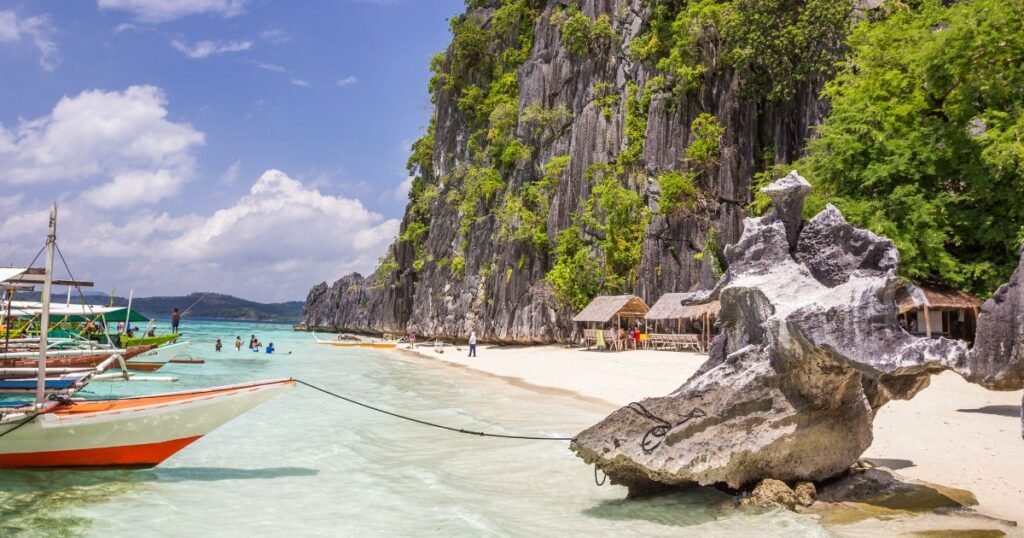
El Nido a popular Island Destination in The Philippines
The Island Hopping Challenge
The primary cost driver in the Philippines is transportation between islands. Unlike the mainland, you can’t just hop on a bus. Getting from one island group to another often requires a flight. Your budget strategy here is like a game of chess; you need to plan your moves carefully. Book flights well in advance with budget carriers like Cebu Pacific or AirAsia to get the best fares. Alternatively, for shorter distances, a network of ferries connects many islands. These are slower but much cheaper than flying. Plan a logical route that minimizes backtracking to save both time and money.
Where to Find the Best Value
Popular islands like Boracay and parts of Palawan (like El Nido) have become quite expensive. To save money, seek out less-famous but equally beautiful alternatives. Islands like Siquijor, known for its mystical healers and quiet beaches, or Siargao, a surfing mecca that still retains a laid-back vibe, offer better value. Even on popular islands like Cebu, you can escape the high prices by staying in smaller towns away from the main tourist resorts. Look for locally-run guesthouses and “sari-sari” stores (small neighbourhood convenience shops) for cheap snacks and drinks.
Managing Your Money
Once you are on an island, costs are low. Local food, especially grilled fish and rice, is affordable. Tricycles (motorbikes with a sidecar) are the standard mode of local transport and fares are negotiable, so always agree on a price before you get in. The key to a budget trip in the Philippines is to spend more time in fewer locations. Rushing to see five islands in two weeks will inflate your budget with transport costs. Instead, pick two or three islands and explore them deeply. This approach is not only cheaper but also far more rewarding.
FAQs
What are some of the best budget destinations in South East Asia?
Some of the best budget destinations in South East Asia include Thailand, Vietnam, Cambodia, Laos, and Indonesia. These countries offer affordable accommodation, food, and transportation options for budget travelers.
What are some tips for travelling cheap in South East Asia?
Some tips for traveling cheap in South East Asia include staying in budget accommodations such as hostels or guesthouses, eating at local street food stalls, using public transportation, and booking flights and activities in advance to take advantage of discounts.
What are some affordable activities to do in South East Asia?
Some affordable activities to do in South East Asia include visiting temples and historical sites, exploring local markets, taking cooking classes, hiking in national parks, and enjoying the beautiful beaches and islands in the region.
What are the best ways to save money on transportation in South East Asia?
The best ways to save money on transportation in South East Asia include using local buses and trains instead of taxis, booking flights in advance to get the best deals, and considering alternative modes of transportation such as renting a scooter or bicycle.
Are there any cultural considerations to keep in mind when traveling in South East Asia?
When traveling in South East Asia, it’s important to respect the local customs and traditions. This may include dressing modestly when visiting temples, removing shoes before entering someone’s home, and being mindful of local etiquette and social norms.

